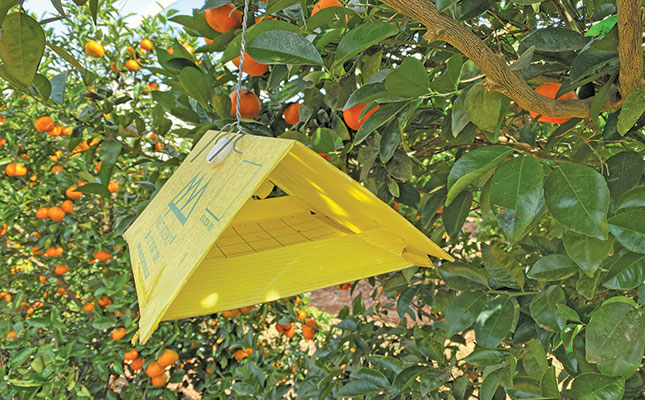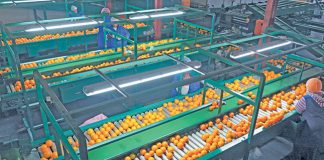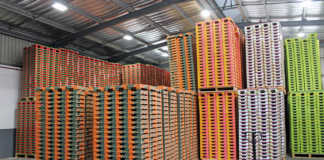
Photo: Magda du Toit
Agricultural research and farming practices are increasingly driven by recognition of the need for sustainable agriculture and lower environmental impact.
In one such example, Mahela Group, in collaboration with the Komati Fruit Group and Laeveld Sitrus, recently teamed up with a local entrepreneur in a joint venture to develop a state-of-the-art insectary situated in the town of Letsitele in Limpopo.
Founded in 2015, Insectec has expanded from a small laboratory in Tzaneen to become a leader in the production of natural insect predators for use in integrated pest management (IPM) systems on South African farms.
The new insectary, which is now Insectec’s main facility, boasts the latest technology and a local research and development team that enables the company to address the specific needs of its clients.
“Although we might be a bit cheeky to claim as much, we believe that we have the largest insectary in the Southern Hemisphere,” says Karel van Heerden, CEO of Insectec.
“Our mission is to produce integrated and sustainable solutions for pest management that contribute to healthier and more productive agricultural systems.”
The insectary is run by director and production manager Hannah Otto, who is renowned for her expertise in insect breeding under South African conditions. The facility focuses
on the production and application of beneficial organisms used in biological pest control and IPM programmes.
Insects will be mass-produced to support the IPM programmes of citrus and grape farmers both locally and internationally.
Biological pest control uses living organisms to suppress pest densities, and is centred on using one type of organism, the ‘natural enemies’, to control another, the pest species.
Pests such as insects, mites, weeds and plant diseases are thus controlled via predation, parasitism, herbivory or other natural mechanisms.
Restoring the balance
The purpose of biological control is to restore the balance between pests and their natural enemies to keep the former, as well as diseases, at acceptable levels. The aim, however, is not to eradicate them altogether, as they also have a role to play in nature.
In most cases, farmers incorporate natural enemies into their IPM programmes. IPM is a system of managing pests in agricultural crops through a combination of biological, cultural, physical and chemical control methods.
In many instances, the overuse of chemical pesticides has led to problems such as pesticide resistance, outbreaks of previously suppressed pests, as well as environmental contamination. IPM evolved as a way of addressing these problems.
IPM systems aim to reduce the use of non-selective chemicals and produce healthy crops with minimal impact on the environment and human health. Some of the major components of IPM programmes are:
- The accurate identification of pests;
- Regular and continual monitoring of pests and the damage they cause to crops;
- Determining threshold levels in order to know when action needs to be taken;
- Prevention;
- The implementation of a combination of the biological, cultural, physical, and chemical control methods; and
- The evaluation of the effect of pest management.
Breeding natural enemies
“To breed the natural enemies [of plant pests], we have to breed their prey. At this stage, the only prey we breed are mealybugs (family Pseudococcidae), economically important pests of citrus, grape vines, mangoes and pome fruit. Mealybugs are scaled, soft-bodied insects that are extremely difficult to control with chemicals. The use of natural enemies is considered the best alternative means of control,” says Otto.
All of the natural enemies produced at Insectec occur naturally in South Africa, and are therefore adapted to most regions in the country.
Insectec breeds four natural enemies of mealybugs, giving each a brand name. Each species targets a different life stage of the pest, and in some instances can be used to complement one another to control different species of mealybug. However, some are host-specific and only target certain mealybug species.
“The ladybird [species] Crypto-Tec (Cryptolaemus montrouzieri) targets all mealybug stages and most mealybug species, and is compatible with a wide range of crops, from citrus to pome fruit and even sweet peppers. The other predatory beetle that we produce, Neph-Tec (Nephus kamburovi), however, is a tiny beetle that feeds only on mealybug eggs and mealybugs in the early life stage,” she explains.
In addition to these two predatory beetles, Insectec produces two parasitic wasps, Ana-Tec (Anagyrus vladimiri) and Cocci-Tec (Coccidoxenoides perminutus), which are used simultaneously in situations where the citrus mealybug is the dominant species in the orchard, as these two wasps complement each other by targeting different life stages of the mealybug.
Effective and sustainable
A typical biological control programme to manage a light infestation of citrus mealybugs in an orchard will entail the simultaneous release of about 1 000 Ana-Tec and 15 000 Cocci-Tec wasps per hectare.
“Each situation is different, and the ‘dosages’ are dependent on many factors, such as region, climate, mealybug species, infestation level, and the lifespan of the pest at that particular moment,” says Otto.
The breeding quantities of each natural enemy for a particular season are based on planned releases, as well as historical data of past releases, and weather conditions will determine when the releases take place.
Normally, the predators are not released during winter in areas known for very low temperatures, as their growth and activity slow down under these conditions.
“The effectiveness of using natural enemies to control pests is impossible to ignore, and therefore [these natural enemies] have become an integral part of IPM programmes throughout the world,” says Van Heerden.
Consumers are increasingly demanding more sustainably produced food, and farmers themselves are becoming increasingly conscious of the pest control methods they apply on their farms. Therefore, more and more are starting to implement IPM systems on their lands.
Eddie Vorster, director of citrus production at Mahela Group, explains that biological pest control is the cornerstone of their IPM strategy.
“We introduced biological pest control in fruit production as part of our strategy to reduce the use and impact of pesticides on the environment and biodiversity.
“Using available biodiversity to curb pests is an exact science, and to this end, the insectary [at Insectec] will play an important role in facilitating our IPM programmes that focus on the long-term prevention and management of pests.
“We see ourselves as custodians of nature and strive to produce fruit in an environmentally sustainable and responsible manner. Using nature’s natural order to restore balance in our fruit orchards is sustainable and ultimately beneficial for fruit production and agriculture in general.”
A change of approach
In the past, farmers who produced fruit in monoculture systems relied heavily on chemicals only to produce quality pest- and disease-free fruit. Today, it is widely accepted that, in terms of sustainability, this is not a good option.
While fruit growers still employ chemical control measures, about three to four months prior to the harvesting season they need to find alternative ways to control pests and diseases due to the maximum residue limits placed on chemical usage. This is where the true value of biological pest control in an IPM system, and the role that Insectec’s new insectary can play, come to the fore.
“To be a successful grower, one needs to understand the balance that nature provides,” says Karlien Grobler, group quality manager at the Komati Fruit Group. According to her, the incorporation of biological control measures remains a challenge, especially without a continual supply of beneficial insects.
“At Komati, we plan the chemical interventions we apply for thrips, red scale, mealybugs and blackspot carefully and timeously to get the control we require with as little disruption of the natural balance as possible. When the risk period for damage ceases, we top up our beneficial complex with biological insects supplied by Insectec to sustain us through the remainder of the season.”
Grobler adds that these practices enable the Komati Fruit Group to produce quality fruit with low residue levels, while also protecting the environment.
“The incorporation of the integrated approach Insectec provides allows Komati to supply to European markets, which require limited residue on the fruit,” she says.
Email Insectec at [email protected], phone 063 884 5080, or visit insectec.co.za.











